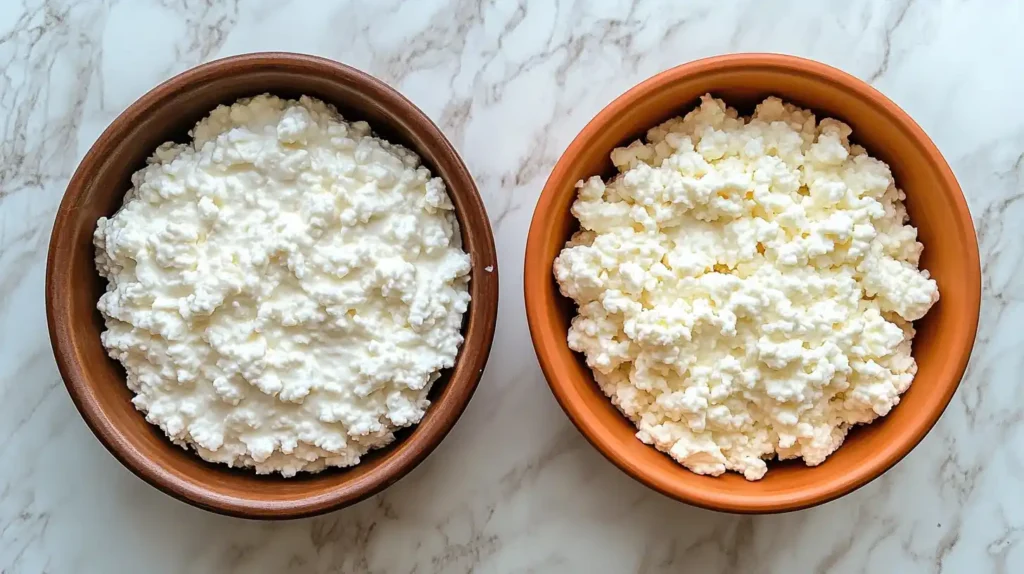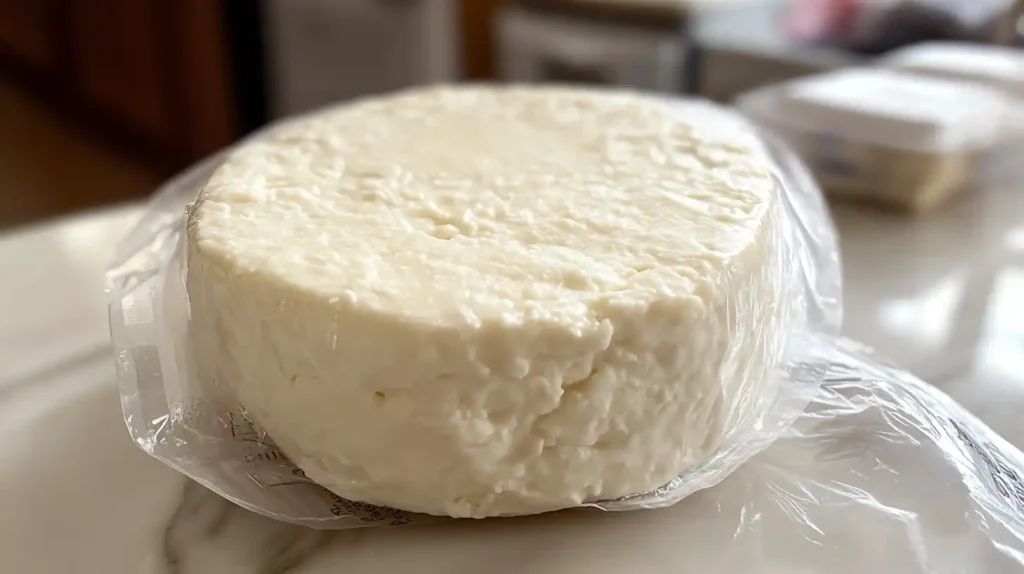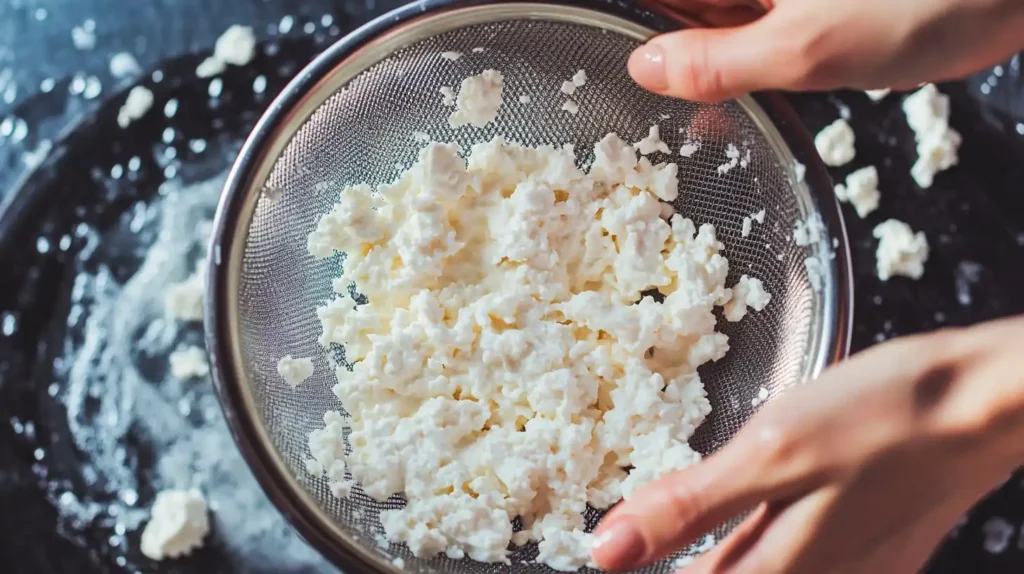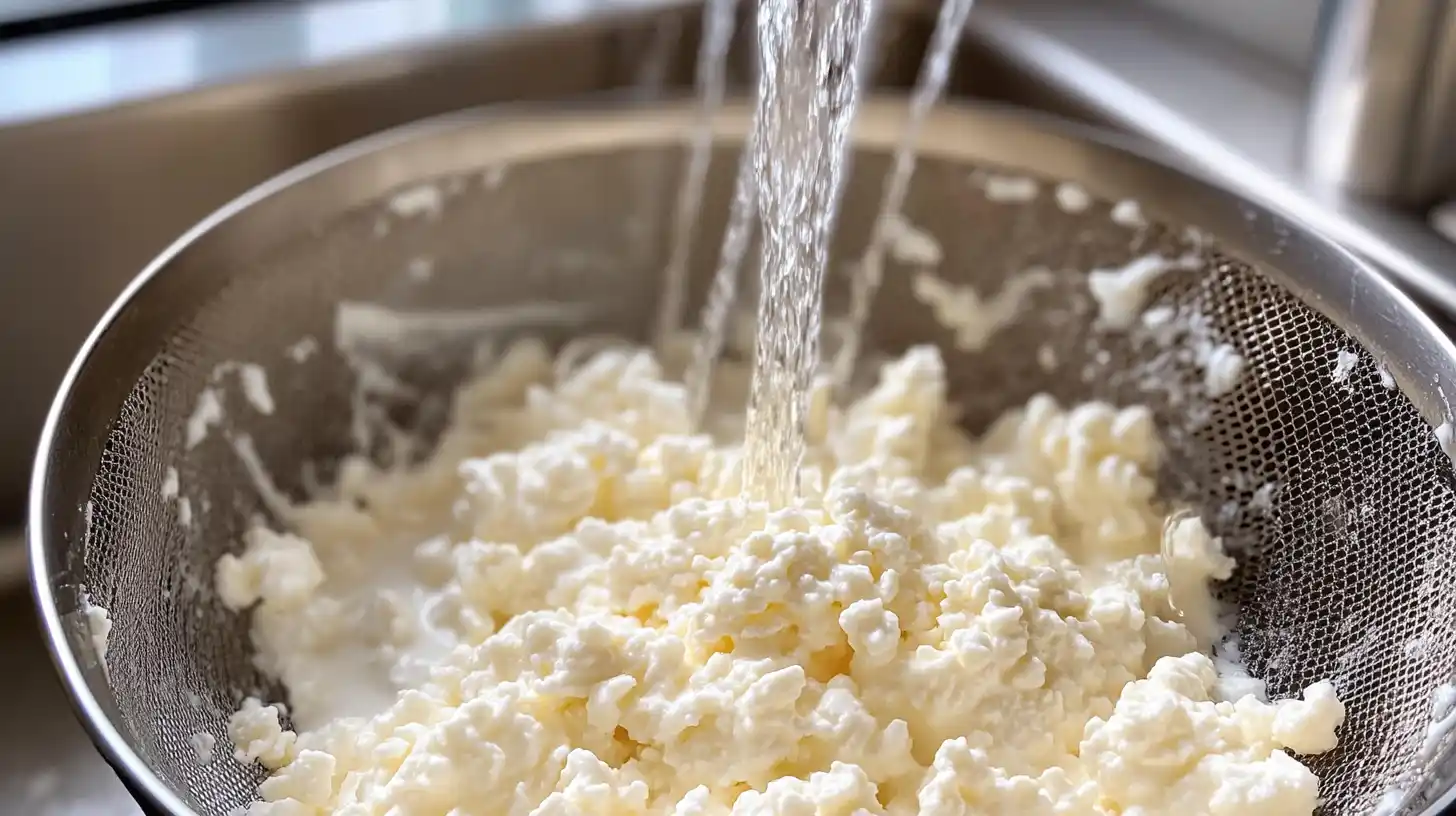Cottage cheese is a well-loved dairy product. Many people eat it because it is high in protein and easy to use in meals. But some people choose to rinse cottage cheese before eating it.
The main reason? Sodium reduction. Most brands add salt to cottage cheese to improve taste and texture. However, too much sodium is not healthy. It can raise blood pressure and increase the risk of heart disease. Some people also rinse it to make it less sour or less creamy.
But here’s the big question: Does rinsing cottage cheese remove important nutrients like protein and calcium? Or is it a simple trick to make it healthier? Let’s explore the facts to find out.
What is Cottage Cheese?
Cottage cheese is a soft, fresh cheese made by curdling milk. Unlike hard cheeses, it does not age. This makes it mild in taste and soft in texture.
Different Types of Cottage Cheese
There are a few types of cottage cheese, and each has its own texture and flavor:
- Regular cottage cheese – Comes with a creamy liquid, called whey.
- Low-fat cottage cheese – Has less fat but still contains whey.
- Dry-curd cottage cheese – Has no added cream, making it drier and firmer.
Most store-bought brands contain added salt. In fact, some brands have over 400 mg of sodium per serving. That’s a lot, especially for people trying to eat less salt!
Why Do People Rinse Cottage Cheese?
Many people rinse cottage cheese for different reasons. Some want to lower sodium, while others prefer a milder taste or a different texture. Let’s break down the main reasons why rinsing is popular.
1. Reducing Sodium Levels
Sodium is a big concern in processed foods, including cottage cheese. Most brands add a lot of salt to improve flavor and shelf life.
- A half-cup serving of regular cottage cheese can have 300 to 500 mg of sodium.
- That’s 20% of the daily limit for someone on a low-sodium diet.
- High sodium intake can lead to high blood pressure, heart problems, and kidney issues.
Since sodium dissolves in water, rinsing cottage cheese under cold running water can wash away some of the salt. This helps make it healthier for those watching their sodium intake.
2. Improving Taste
Some people find cottage cheese too salty or too tangy. Rinsing helps make it milder, making it more enjoyable in both sweet and savory recipes.
For example, rinsed cottage cheese pairs well with fruits in desserts. If you enjoy creative baking, you might like these sweet and nutritious cottage cheese brownies.
3. Changing the Texture
Cottage cheese comes with a thick, creamy liquid. Some people don’t like how it feels in the mouth. Rinsing it can:
Make it drier and firmer – This is great for salads or cooking.
Reduce the stickiness – It won’t feel as wet or heavy.
Make it more crumbly – Similar to ricotta or feta cheese.
If you prefer cottage cheese with a firm texture, rinsing might be a good option.
4. Making It More Versatile in Recipes
Rinsed cottage cheese works well in many dishes. Without the extra salt and creaminess, it blends better into both sweet and savory recipes. You can use it in:
- Smoothies – Adds protein without changing the taste.
- Salads – Stays firm and doesn’t make greens soggy.
- Baking – Works as a low-fat substitute for ricotta.
- Egg dishes – Mixes well without extra liquid.
Want to experiment with rinsed cottage cheese? Try it in different meals and see what you like best!

Does Rinsing Cottage Cheese Remove Nutrients?
Rinsing cottage cheese may lower sodium, but it can also wash away some important nutrients. Many people wonder if it’s worth the trade-off. Let’s take a closer look at what happens when you rinse cottage cheese.
1. Does Rinsing Reduce Protein?
Cottage cheese is a high-protein food, making it a favorite among athletes and health-conscious eaters. However, some protein loss can occur when rinsing.
- The liquid (whey) contains some protein.
- Rinsing washes away this whey protein.
- However, most of the casein protein (the main protein in cheese) stays in the curds.
💡 Good news! The majority of the protein remains intact even after rinsing. So, if you’re eating cottage cheese for muscle building or weight loss, you don’t need to worry too much about losing protein.
2. Does It Affect Calcium Levels?
Cottage cheese is also rich in calcium, which is essential for strong bones and teeth. But when you rinse it, some calcium may be lost.
- Calcium is mostly found in the curds, so most of it stays.
- A small amount dissolves in the whey, which gets washed away.
If you rely on cottage cheese for calcium intake, you might want to skip rinsing or find other calcium-rich foods to balance your diet.
3. What About Probiotics?
Some brands of cottage cheese contain live probiotics. These are good bacteria that help with digestion and gut health.
- Not all cottage cheese has probiotics – Only brands labeled with live cultures contain them.
- Rinsing removes probiotics – Since they live in the liquid, washing it away means losing them.
👉 If you eat cottage cheese for gut health, check the label to see if it has probiotics. If it does, avoid rinsing to keep the benefits.
4. Is Rinsing Worth It?
Now that we know rinsing removes some nutrients, is it still a good idea? It depends on your health goals.
Rinsing is a good option for reducing sodium.
Skipping the rinse helps preserve probiotics.
Protein content remains nearly the same, so rinsing does not make a big difference.
A good alternative is choosing a low-sodium brand instead of rinsing. Check out these low-sodium cheese options to find a better fit for your diet.

How to Rinse Cottage Cheese Properly
If you decide to rinse cottage cheese, doing it the right way can help reduce sodium while keeping as many nutrients as possible. Follow these simple steps for the best results.
1. Use the Right Tools
To rinse cottage cheese, you’ll need:
A fine-mesh strainer – Prevents small curds from falling through.
Cold running water – Warmer water can affect the texture.
A bowl (optional) – Helps if you don’t have a strainer.
2. Step-by-Step Rinsing Guide
Follow these easy steps to rinse cottage cheese properly:
Place it in a strainer
- Pour the cottage cheese into a fine-mesh strainer or sieve.
- If you don’t have one, you can use a cheesecloth over a bowl.
Rinse under cold running water
- Use gentle water flow to avoid breaking the curds.
- Stir lightly with a spoon or fork to help remove excess whey.
Let it drain
- Hold the strainer over the sink for 30–60 seconds.
- Shake lightly to remove extra water.
Pat dry (optional)
- If you want a firmer texture, pat the cottage cheese with a paper towel or clean cloth.
3. How Much Salt Does Rinsing Remove?
Rinsing can remove up to 30% of the sodium in cottage cheese. However, the exact amount depends on:
- How long you rinse – More rinsing = less sodium.
- The type of cottage cheese – Some brands have higher sodium than others.
- How well you drain it – More water removed = drier texture.
💡 Tip: If you want to lower sodium without rinsing, try low-sodium cottage cheese or dry-curd cottage cheese instead.
4. Does Rinsing Change the Taste?
Yes, rinsing cottage cheese makes it:
Less salty – Perfect for mixing with fruits or honey.
Less sour – Makes it milder and easier to blend into recipes.
Drier and firmer – Ideal for salads or cooking.
If you miss the creaminess, you can mix it with plain yogurt or a splash of milk after rinsing.

Does Rinsing Cottage Cheese Affect Cooking?
Many recipes call for unrinsed cottage cheese because of its creamy texture. But if you rinse cottage cheese, it can still work well in many dishes—you just need to use it the right way.
Let’s look at how rinsing changes its use in cooking and baking.
1. How Rinsing Changes Texture in Recipes
Rinsed cottage cheese becomes drier and less creamy. This makes it better for some dishes but less ideal for others.
✔ Great for:
- Salads (won’t make greens soggy)
- Egg dishes (scrambles, omelets, quiches)
- Pasta dishes (works as a ricotta substitute)
- Smoothies (adds protein without extra liquid)
- Baking (can replace ricotta in cheesecakes or muffins)
✘ Not ideal for:
- Creamy dips (rinsing removes the smooth texture)
- Spreads (becomes too crumbly and dry)
💡 Tip: If a recipe needs a creamier consistency, add a little yogurt, milk, or sour cream after rinsing.
2. Using Rinsed Cottage Cheese in Savory Dishes
If you’re making savory meals, rinsed cottage cheese can be a great ingredient. Here’s how you can use it:
- Pasta dishes – Use rinsed curds instead of ricotta in lasagna.
- Egg recipes – Add it to scrambled eggs or omelets for extra protein.
- Salads – Toss rinsed cottage cheese into a Greek salad for a fresh taste.
Since rinsing removes some salt, you might need to add a little seasoning to balance the flavor.
3. Using Rinsed Cottage Cheese in Sweet Recipes
Rinsed cottage cheese works well in certain recipes, while in others, the creaminess is essential.
Best Uses for Rinsed Cottage Cheese
- Salads – Drier curds mix well with greens.
- Scrambled eggs – Adds protein without extra liquid.
- Pasta dishes – Works as a substitute for ricotta.
- Smoothies – High-protein option without a strong dairy taste.
For those who love pasta, you might enjoy these delicious spaghettini pasta recipes, where rinsed cottage cheese can be a great addition.
4. Does Rinsing Affect Baking?
In baking, cottage cheese is often used as a moisture-rich ingredient. Rinsing removes some of the liquid, so you may need to adjust the recipe.
💡 Baking tips with rinsed cottage cheese:
- If replacing ricotta, add a splash of milk to restore moisture.
- For cakes and muffins, blend rinsed cottage cheese until smooth before mixing.
- For cheesecakes, use rinsed curds but add extra cream or yogurt.
5. Should You Rinse Before Cooking?
It depends on what you’re making.
- If you want a firmer texture, rinsing is a good idea.
- If you need a creamy texture, keep it as is or mix with yogurt.
- If you want to reduce sodium, rinsing is a great option—but season your dish to adjust the flavor.
👉 Still not sure? Try rinsing half of your cottage cheese and leaving the rest creamy to compare the difference!
FAQs About Rinsing Cottage Cheese
1. Does rinsing cottage cheese remove all the sodium?
No, but it does reduce a good amount. Rinsing under cold water can lower the sodium by about 20 to 30 percent. Some salt will still remain in the curds, but the overall amount will be less than before.
2. Does rinsing cottage cheese remove protein?
A small amount of protein is lost when rinsing, but most of it stays in the curds. The casein protein, which is the main type in cottage cheese, does not dissolve in water. Some whey protein may wash away, but the total loss is minor.
3. Can I store rinsed cottage cheese?
Yes, but it does not last as long as unrinsed cottage cheese. After rinsing, store it in an airtight container in the fridge and eat it within one or two days. If it becomes too dry, you can mix in a little yogurt or milk to bring back moisture.
4. Does rinsing remove probiotics?
Yes, if the cottage cheese contains live cultures, rinsing will wash them away. Not all brands have probiotics, so check the label before buying. If you want to keep the probiotics, it is best not to rinse.
5. How does rinsing affect cooking?
Rinsing changes the texture of cottage cheese, making it drier and firmer. This works well in some dishes but not in others.
Best for:
- Salads
- Pasta dishes
- Scrambled eggs
- Baking (if mixed with yogurt or milk)
Not ideal for:
- Creamy dips
- Spreads
If a recipe needs a smooth consistency, adding yogurt or milk after rinsing can help.
6. Can I rinse cottage cheese with something other than water?
Yes, rinsing with milk instead of water is an option. This removes some of the salt while keeping the texture smoother. It works well for those who want less sodium but do not want the cheese to be too dry.
7. Is it better to buy low-sodium cottage cheese instead of rinsing?
That depends on preference. Low-sodium cottage cheese already has less salt, so there is no need to rinse it. If you cannot find a low-sodium version, rinsing regular cottage cheese is an easy way to reduce salt. Dry-curd cottage cheese is another option since it has no added salt.
8. Does rinsing change the taste?
Yes, rinsing makes cottage cheese taste milder. The salty and tangy flavors become weaker, giving it a more neutral taste. This can make it easier to mix with fruits, honey, or herbs.
9. Can I use rinsed cottage cheese in smoothies?
Yes, rinsed cottage cheese works well in smoothies. It blends smoothly without adding extra saltiness. It also gives the smoothie a good protein boost without affecting the flavor. If you want a creamier texture, adding a little milk or Greek yogurt can help.
10. Should I rinse cottage cheese every time I eat it?
Not necessarily. It depends on personal preference and dietary needs.
- If you are limiting sodium, rinsing is a good idea.
- If you enjoy the natural taste and texture, there is no need to rinse.
- If you rely on probiotics, rinsing is not recommended.
Final Thoughts: Should You Rinse Cottage Cheese?
Ultimately, whether or not you rinse cottage cheese depends on your personal preference and dietary needs. If you’re watching your sodium intake, rinsing cottage cheese can help reduce salt levels without significantly affecting its protein content. However, if you value probiotics and calcium, you might want to consider low-sodium alternatives instead.
So, next time you open a container of cottage cheese, think about your taste preferences and health goals. Whether you choose to rinse cottage cheese or not, there are plenty of ways to enjoy it in a healthy diet!

